How Mexican drug cartels are moving into Hong Kong
Mexican cartels are using Hong Kong to launder money and source chemicals for narcotics trade
PUBLISHED : Wednesday, 08 April, 2015, 12:41am
UPDATED : Wednesday, 08 April, 2015, 12:41am
Bryan Harris [email protected]
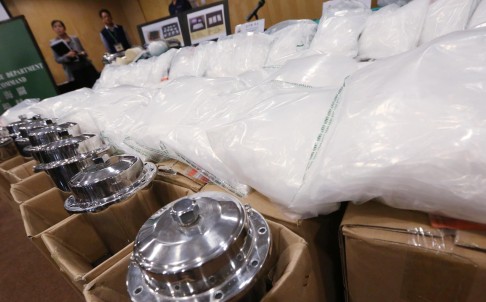
Customs officers with a 104kg haul of Ice seized at Chek Lap Kok in December last year. Photo: Felix Wong
The brutal narcotics turf wars that consumed Mexico for the past decade have left more than 100,000 people dead or missing.
Bodies are frequently dismembered. Victims are often hanged from bridges. Decapitation is common.
Behind the violence and barbarity are the country's notorious drug cartels, which are now eyeing new clients overseas.
Following financial crises in the West, the syndicates sought to target lucrative new cocaine markets in Asia, as well as secure vital supply lines of drug chemicals for the booming American meth market.
Their corporate and criminal presence in Hong Kong has been laid bare in a new investigation by the South China Morning Post, which found evidence of drug cartels using the city for money laundering and sourcing vital chemicals.
One of Mexico's most powerful and violent crime groups, the Sinaloa cartel, has been using banks and shell companies in the city for a number of years to launder millions in dirty money, according to official Mexican documents and interviews with law enforcement sources.
A Kowloon-based pharmaceutical company has also been implicated by special investigators in the Latin American country for allegedly selling controlled chemicals that the cartels use to manufacture meth, also known as Ice.
The revelations follow warnings last month from a senior UN drugs official that corruption in China's pharmaceutical industry was fuelling the flourishing global meth trade.
Named after the state on Mexico's Pacific coast where it was formed, the Sinaloa syndicate is considered one of the world's most sophisticated and dangerous drug-trafficking groups.
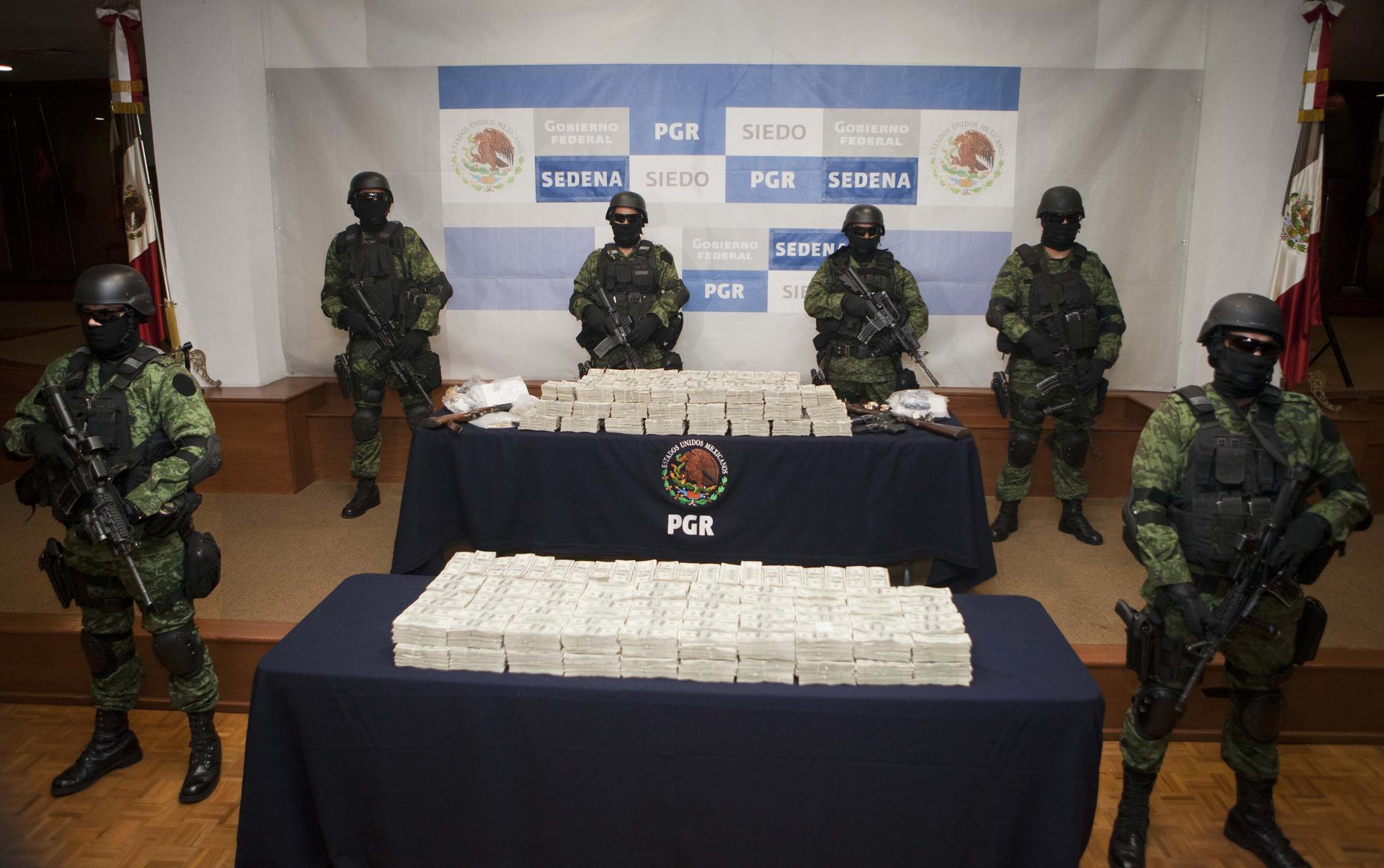
A US5.3 million haul of the gang's cash seized in Mexico. Photo: AP
The Post revealed last year that Hong Kong's triads were supplying the cartel with the chemicals needed to make meth - such as ephedrine and pseudoephedrine - while the cartel also sought to supply the city's growing cocaine market.
Multiple sources within international law enforcement confirmed the "expanding" and "significant" presence of Mexican and other Latin American drug cartels in the region.
In 2013, five Mexicans - including a ringleader who operated out of a port controlled by the Sinaloa cartel - were sentenced to up to 27 years in prison in Hong Kong for smuggling more than half a tonne of cocaine into the city.
The arrests came shortly after the detention of two individuals in the Mexican border city of Juarez for reportedly laundering US$15 million of drug funds through accounts in Hong Kong and the mainland, as well as the United States.
According to a report by the Mexican attorney general's office, Alejandro Loya Quinones and Martha Leticia Mar Campos worked for a crime cell under Ignacio "Nacho" Coronel, a top leader of the Sinaloa cartel.
Known as "The King of Crystal" for his control over the US-Mexico meth trade, Coronel was considered the right-hand man of cartel boss Joaquin "Shorty" Guzman, before being killed in a shoot-out with the Mexican army in 2010.
An investigation by police in Brazil earlier this year revealed the country's largest drug gang, the First Capital Command, maintained at least one bank account in China that was reportedly used to launder dirty money and buy weapons and narcotics.
Colombian crime syndicates were also using shell companies and bank accounts in Hong Kong to launder cash, law enforcement sources told the Post.
"Although Sinaloa is more active than many of its rivals in its projection into the Pacific, it is not the only one," said Robert Evan Ellis, a professor of Latin American Studies at the US Army War College. "Just as Latin American and Chinese businessmen have increasingly built relationships during the last decade … for importing Chinese products to the region and doing transpacific deals, so too have criminal interests built similar relationships facilitating illicit transactions in areas such as precursor chemicals, contraband goods and money laundering."
Both Hong Kong and the mainland were listed as major money laundering jurisdictions, as well as major precursor chemical source areas, in this year's International Narcotics Control Strategy Report by the US State Department, which was released last month.
"The diversion of precursor chemicals originating from China for the illicit production of drugs in other countries remains a significant problem … Chinese-produced precursor chemicals are in high demand by transnational criminal organisations from Mexico, Colombia, West African countries, Iran, and Pakistan," read the report.
Unreported until now, special organised crime investigators in Mexico in 2007 pinpointed Kowloon pharmaceuticals company Vidalab as the supplier of pseudoephedrine - a key meth ingredient - to a narcotics ring in the western Mexican city of Guadalajara.
The company allegedly sold the controlled chemicals to three men who attempted to smuggle the cargo into Mexico by listing it as aspirin. The men are serving sentences of up to 30 years for the offence, according to a report by the Mexican attorney general.
The company, which describes itself as "one of the leading pharmaceutical manufacturers in Hong Kong", said it was "shocked" to learn about the events.
"The company changed hands in 2009 and recently in 2014. The old management from 2007 is no longer with our company and we are therefore unable to comment on the subject," said spokesman Brian Ng.
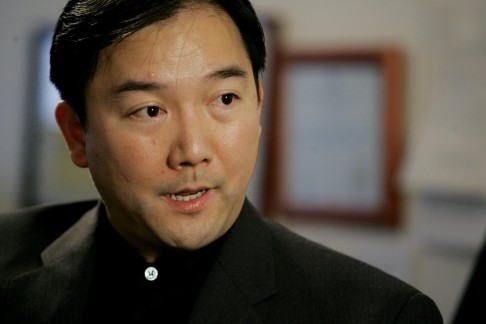
Zhenli Ye Gon, accused of smuggling chemicals to the Sinaloa cartel. Photo: AP
Another key link involves Zhenli Ye Gon, a Hong Kong businessman accused of smuggling around 70 tonnes of illicit precursor chemicals to the Sinaloa cartel between 2005 and 2007.
Currently in detention in the US, the Shanghai native is fighting attempts by the Mexican government to extradite him on charges of money laundering, diversion of controlled chemicals and drug-related offences.
In 2012, he failed to convince the Hong Kong courts to unlock more than US$10 million of alleged drug funds held in a Bank of China account in the city. According to court documents, the funds - frozen at the request of the Mexican government - were held in accounts linked to the businessman and his Hong Kong-registered pharmaceuticals company Unimed.
Known in Mexico and the US as "El Chino", Ye Gon has maintained his innocence and has claimed the US$205 million pile of cash found in his Mexico City mansion was from a political slush fund.
"We are continuing to fight Mexico's extradition request, as we have been doing for more than five years," said Greg Smith, his attorney. "A stay remains in place barring any extradition until the US courts complete their review … The case is currently pending before the US Supreme Court."
Alicia Buenrostro Massieu, the Mexican consul general in Hong Kong, said the consulate was unaware of any information related to organised crime from Mexico in the city.
"International organised crime has no nationality and afflicts countries all around the world," said Buenrostro Massieu.
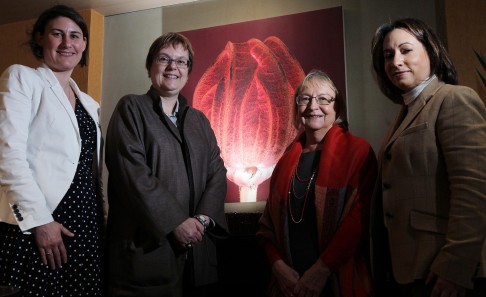
Alicia Buenrostro Massieu (right)
Mexico attached the utmost importance to international collaboration at the multilateral level to eradicate drug trafficking, she added.
A large proportion of the precursor chemicals needed to make meth comes from southern China, in particular Guangdong.
Speaking in the wake of a 2.4-tonne seizure of the powerful stimulant in the province last month - one of the biggest ever in Asia - senior UN drug official Jeremy Douglas said the quick and easy access to precursor chemicals required to make crystal meth clearly pointed to "corruption in the pharmaceutical and or chemical industries".
"To operate a lab like this, you need a lot of chemicals, which are legitimate, regulated chemicals from the pharmaceutical industry," Douglas earlier told the Post.
"There is some kind of corruption in the chemical/pharmaceutical industry taking place allowing this to happen."
According to Mexico's former ambassador to Beijing, Jorge Guajardo, the flow of precursors from China to Mexico was the No1 issue he had to address while in office. However, Chinese authorities were not interested in and did not cooperate on clamping down on the illegal export of the controlled chemicals, the former top diplomat said.
Hong Kong police and customs did not answer specific questions about the presence of Latin American crime cartels in the city, but said they would strive to enhance international cooperation to tackle transnational drug trafficking syndicates.
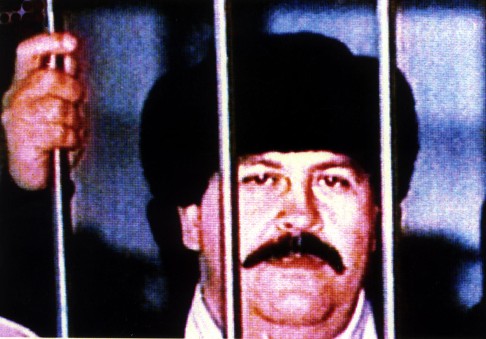
Since Pablo Escobar's death, Mexican cartels have taken over.
From the Colombian hills to the clubs of Hong Kong
The cocaine circulating in Hong Kong's clubbing and nightlife venues typically originates in the mountains of Colombia.
Since the collapse of former drug lord Pablo Escobar's infamous Medellin Cartel in the 1990s, the trade has mostly been run by Mexican syndicates - such as the Sinaloa and Gulf cartels - which smuggle the cocaine from Colombia to the rest of the world.
From time to time, Hong Kong customs officers seize large consignments of cocaine smuggled in by sea. However, more often, the cartels use drug mules who hide the narcotics in their luggage or bodies on long-haul flights.
Since the beginning of the year, officers have cracked 10 cases of mules attempting to smuggle cocaine through the airport in amounts ranging from 1kg to 5kg.
Last year, they uncovered 14 cocaine-related cases, including 12 at the airport.
Once the drugs have reached the city, they are distributed to a network of dealers and pushers who target revellers in the city's nightlife districts.
A gram of the addictive stimulant - which provides users five to 10 "lines" or "hits" - can sell for anything between HK$750 and HK$1,500 depending on the district and customer.
The dealers cover their tracks through a network and will rarely carry the product on their person, making it difficult for police to arrest them.
Once an order has been made, they will call associates waiting nearby who can quickly deliver the drugs.
Police say they conduct regular operations - both overt and clandestine - to shut down gangs.
That's not good enough for residents and business owners in districts such as Wan Chai and Lan Kwai Fong, who complain that the pushers are plying their illegal trade quite openly and with seeming impunity.
